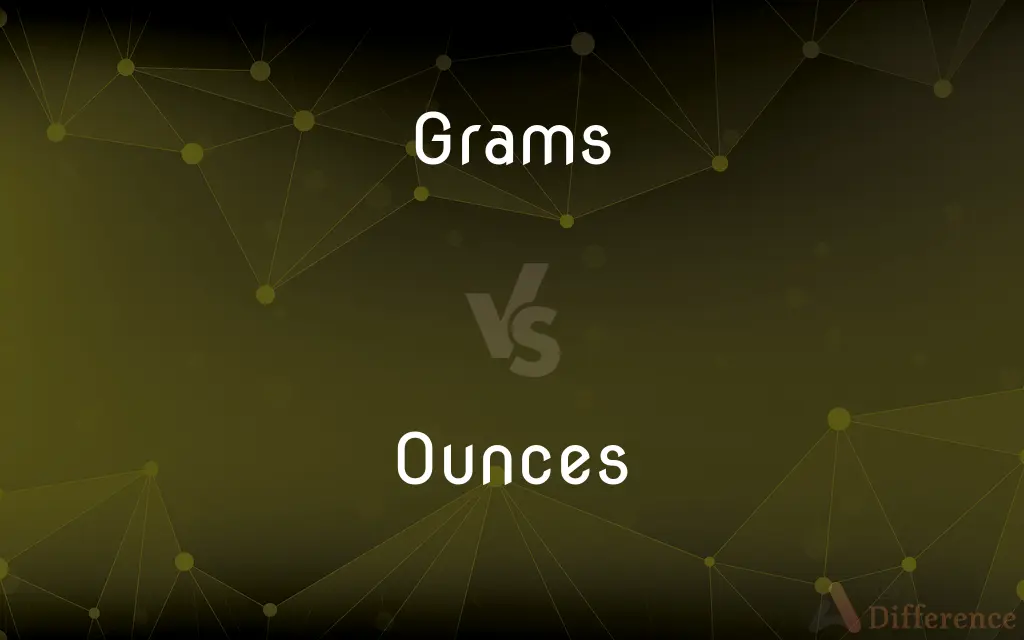Grams vs. Ounces — What's the Difference?
By Maham Liaqat & Fiza Rafique — Updated on April 18, 2024
Grams and ounces are units of measurement for weight; grams are part of the metric system, while ounces are used in the imperial system.

Difference Between Grams and Ounces
Table of Contents
ADVERTISEMENT
Key Differences
Grams are a metric unit of mass, commonly used worldwide and in scientific contexts for its simplicity and universal standardization. Whereas ounces are used primarily in the United States and a few other countries that follow the imperial system, making them less universal but deeply ingrained in certain cultures.
A gram is defined as one-thousandth of a kilogram, the base unit of mass in the International System of Units (SI). On the other hand, an ounce represents 1/16th of a pound in the imperial system, specifically known as the avoirdupois ounce, which is more commonly used than the troy ounce that is typically reserved for precious metals.
In practical terms, because grams are a smaller unit than ounces, they allow for more precise measurements, which is particularly beneficial in scientific and technical fields. Conversely, ounces provide a heftier measure that can be more intuitive for certain types of bulk goods and cooking ingredients in cultures accustomed to the imperial system.
For everyday use, many recipes and packaging in the metric-using countries will indicate weights in grams, which facilitates precise cooking and dietary tracking. Whereas, in the U.S., food items and recipes commonly list ingredients in ounces, reflecting the cultural preference for the imperial system.
The conversion between the two is critical in many fields, including cooking, science, and trade. One ounce is approximately equivalent to 28.35 grams, which is crucial for conversions in recipes, scientific experiments, or international trade where precision is necessary.
ADVERTISEMENT
Comparison Chart
Measurement System
Metric
Imperial
Common Usage
Worldwide, scientific research
Mainly USA, UK for certain uses
Unit Size
Smaller unit (1 gram)
Larger unit (1 ounce = 28.35 grams)
Precision
Allows for more precise measurements
Less precise, suitable for bulk goods
Cultural Context
Used in countries with metric system
Predominantly used in countries with imperial system
Compare with Definitions
Grams
A unit of mass in the metric system, equal to one-thousandth of a kilogram.
The medication must be administered in 5-gram doses.
Ounces
A unit of weight in the imperial system, equal to 1/16th of a pound.
The baby weighed 8 pounds and 4 ounces at birth.
Grams
Commonly used in science for its precision and standardization.
The sample was measured to weigh exactly 250 grams.
Ounces
Used for various applications, from postal weights to boxing classes.
The package needs to be less than 16 ounces to qualify for standard shipping.
Grams
Used worldwide except in countries that still use the imperial system exclusively.
All ingredients were listed in grams for international understanding.
Ounces
Applied in trading precious metals like gold and silver.
Gold prices are often quoted per ounce on the market.
Grams
Essential for precise cooking and baking measurements.
The recipe called for 100 grams of flour.
Ounces
Essential in recipes and cooking in the United States.
The stew recipe requires 12 ounces of beef.
Grams
Integral to dietary tracking and nutrition.
She tracked her food intake down to the gram to meet her health goals.
Ounces
Used to measure liquids in culinary settings in the U.S.
She added two ounces of syrup to the cocktail.
Grams
A grandmother.
Ounces
A unit of weight in the US Customary System, an avoirdupois unit equal to 437.5 grains (28.35 grams).
Grams
Plural of gram
Ounces
A unit of apothecary weight, equal to 480 grains (31.103 grams). See Table at measurement.
Grams
Grandmother
Ounces
A fluid ounce. See Table at measurement.
Ounces
A tiny bit
Not an ounce of sympathy.
Ounces
See snow leopard.
Ounces
Plural of ounce
Common Curiosities
What is an ounce?
An ounce is a unit of weight in the imperial system, primarily used in the U.S. and for certain applications in the UK.
How do grams compare to ounces in terms of size?
One ounce is approximately 28.35 grams; hence, grams are a smaller and more precise unit of measurement.
What is a gram?
A gram is a unit of mass in the metric system, used globally for scientific and general purposes.
Why do some countries use grams while others use ounces?
The choice between grams and ounces typically depends on whether a country uses the metric or imperial system.
Can you convert grams to ounces easily?
Yes, to convert grams to ounces, divide the number of grams by 28.35.
Why are grams considered more precise?
Because grams are a smaller unit, they allow for more detailed and exact measurements, especially important in scientific contexts.
Is there a trend in the usage of grams and ounces?
There is a trend towards wider adoption of the metric system globally, increasing the use of grams even in traditionally imperial countries.
What are the implications of using different units in recipes?
Using different units can lead to confusion and inaccuracies in measurements unless proper conversions are used.
Will the U.S. ever switch completely to the metric system?
While there has been some movement towards metrication in the U.S., a complete switch is uncertain and would require significant changes in legislation, education, and public acceptance.
Where are ounces most commonly used?
Ounces are most commonly used in the United States and for specific purposes in the UK, such as in cooking and postal services.
What challenges arise from using two different systems?
Challenges include the need for conversion and potential for measurement errors, impacting activities like cooking, shipping, and trade.
How do I convert ounces to grams for cooking?
To convert ounces to grams in cooking, multiply the number of ounces by 28.35.
How important is it to understand both grams and ounces?
Understanding both units is crucial for international cooking, scientific research, and global trade.
What unit should I use for scientific measurements?
For scientific measurements, grams are preferred due to their universal acceptance and precision.
Which unit is better for tracking dietary intake?
Grams are typically better for tracking dietary intake due to their smaller unit size, which allows for more precise measurement of food quantities.
Share Your Discovery

Previous Comparison
Moderate vs. Radical
Next Comparison
Shinner vs. ShinerAuthor Spotlight
Written by
Maham LiaqatCo-written by
Fiza RafiqueFiza Rafique is a skilled content writer at AskDifference.com, where she meticulously refines and enhances written pieces. Drawing from her vast editorial expertise, Fiza ensures clarity, accuracy, and precision in every article. Passionate about language, she continually seeks to elevate the quality of content for readers worldwide.















































